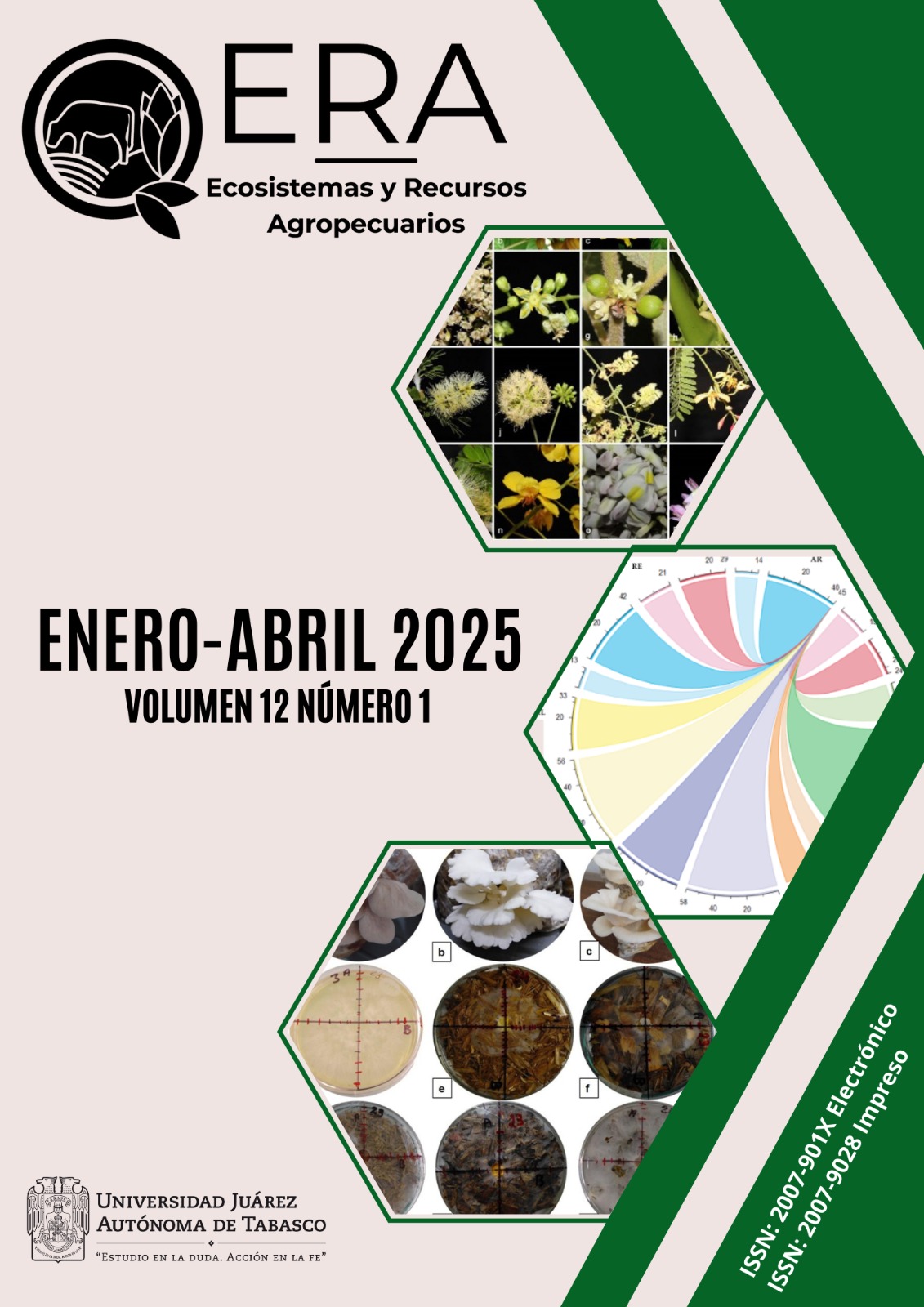Effect of compaction on the nutritional quality of corn silage
DOI:
https://doi.org/10.19136/era.a12n1.4113Keywords:
Non-fibrous carbohydrates, chemical composition, cell content, fodder, soluble crude proteinAbstract
Eight 4.05 L micro silos were prepared containing 2.35 to 3.54 kg of corn green fodder (GF) or 587 to 873 kg GF m-3 (182 to 271 kg DM m-3), compaction that was considered the independent variable. The following dependent variables were measured in the silage: moisture (Mst), ashes (Ash), ether extract (EE), crude protein (CP), neutral detergent insoluble crude protein (NDICP), soluble crude protein (SCP), neutral detergent fiber (NDF), acid detergent fiber (FDA), hemicelluloses (Hem), cellulose (Cell), lignin (Lig), silica (Sil), cell content (CC) and non-fibrous carbohydrates (NFC). Linear (L) and quadratic (Q) regression equations were obtained for the dependent variables as a function of compaction. The variables Mst (79.3 to 77.3%, L and Q), EE (5.2 to 1.8%, L and Q), CC (51.8 to 38.6%, Q) and SCP (8.8 to 7.6%, Q) decreased (P < 0.05) with increasing forage compaction, whereas CP (9. 2 to 10.6%, L), NDICP (1.5 to 3.1%, L), NDF (48.2 to 59.4%, Q), ADF (30.2 to 40.0%, Q) and Sil (0.9 to 2.7%, Q) increased (P < 0.05). The most soluble variables reached a maximum at 735 kg GF m-3, while the fibrous variables reached a minimum at this compaction. It is suggested to compact corn green fodder at 735 kg GF m-3 (equivalent to 227 kg DM m-3) to achieve the maximum values of soluble crude protein, ether extract and cell content, and the minimum values of fibrous components.
Downloads
References
AOAC (2012) Official Methods of Analysis.19th Edition. Association of Official Analytical Chemists. Gaithersburg, Mary Land, USA. Chapter 4: 1-44.
Cuevas-Reyes V, Meza AL, Gutiérrez OGG, Bravo MB, Rosales-Nieto CA (2024) Tipología de productor y efectos indirectos del cambio climático en la ganadería bovina en Sinaloa. Revista Mexicana de Ciencias Pecuarias 15(3): 555-569. https://doi.org/10.22319/rmcp.v15i3.6529
García-Chávez I, Meraz-Romero E, Castelán-Ortega O, Zaragoza-Esparza J, Osorio-Avalos J, Robles-Jiménez LE, González-Ronquillo M (2022) Corn silage, a systematic review of the quality and yield in different regions around the world. Ciencia y Tecnología Agropecuaria 23(3). https://doi.org/10.21930/rcta.vol23_num3_art:2547
Gómez-Rodríguez VM, Heredia ND, Ramírez VH, García MA, Olmos CJ de J (2017) Diagnóstico de la calidad de los ensilados de maíz en los Altos de Jalisco. In: Cavallotti-Vazquez BA, Cesín-Vargas JA, Ramirez- Valverde B (coords) Estudios sociales y económicos de la producción pecuaria. Universidad Autónoma Chapingo,Chapingo, Estado de México. pp. 79-88.
Hentz F, Pedro-Velho J, Laerte-Nörnberg J, Pereira-Haygert V, Lone M, Henz-Éderson L, Dionísio-Henn J, Peripolli V, Bernardi-Zardin P (2017) Fracionamento dos carboidratos e dos constituintes nitrogenados de silagens de milho safrinha ensiladas com diferentes massas. Ciencias Agrarias 38(1): 491501.
Hutnik E, Kobielak S (2012) Density of silage stored in horizontal silos. Acta Agrophysica 19(3): 539-549.
Krüger AM, Jobim CC, de Carvalho, IQ, Moro JG (2017) A simple method for determining maize silage density on farms. Tropical Grasslands-Forrajes Tropicales 5(2): 94-99. https://doi.org/10.17138/tgft(5)94-99
Krüger AM, Lima PMT, Abdalla FAL, Moro JG, de Carvalho IQ, Abdalla AL, Jobim CC (2020) Dry matter concentration and corn silage density: Effects on forage quality. Tropical Grasslands-Forrajes Tropicales 8(1): 20-27. https://doi.org/10.17138/tgft(8)20-27
Mertens D, Allen M, Carmany J, Clegg J, Davidowicz A, Drouches M, Frank K, Gambin D, Garkie M, Gildemeister B, Jeffress D, Jeon CS, Jones D, Kaplan D, Kim GN, Kobata S, Main D, Moua X, Paul B, Wolf M (2002) Gravimetric determination of amylase-treated neutral detergent fiber in feeds with refluxing in beakers or crucibles: Collaborative study. Journal of AOAC International 85: 1217-1240.
Neumann M, Baldissera E, Ienke LA, De-Souza AM, De-Oliveira PEP, Bumbieris VH (2024) Nutritional value evaluation of corn silage from different mesoregions of Southern Brazil. Agriculture 14(7): 1055. https://doi.org/10.3390/agriculture14071055
NRC (2016) National Research Council. National Academy of Science, Nutrient Requirements of beef cattle. Committee of Nutrient Requirements of beef cattle. Eight editions. Washington DC. National Academy Press. 475p. https://doi.org/10.17226/19014
Şahin M, Tan F (2019) Examination of the measurement methods used to determine the silage densityin small farm. Avrupa Bilim ve Teknoloji Dergisi 17: 744-749.
Toledo EA, Pertile SFN, Sifuentes-dos-Santos J, Barreto JVP, Banchero G, Dos-Santos MD, Venancio RL, Ribeiro ELA, Zamboti M, Zundt M (2020) Does compaction degree and particle size influence bromatological composition and mycotoxin levels in corn silage? Scientia Plena 16(7): 070207 - 1. https://doi.org/10.14808/sci.plena.2020.070207
Tsopgni LT, Lemoufouet J, Meutchieye F, Nounamo LWE, Kondo CN, Kana JR Mouchili M, Feudjio BA (2023) Nutritive value of forages consumed by ruminants during the dry season in the Western Highlands of Cameroon. Grassland Research 2(2): 112-119. https://doi.org/10.1002/glr2.12051
Van-Soest PJ, Robertson B, Lewis BA (1991) Methods for dietary fiber, neutral detergent fiber and non-starch polysaccharides in relation to animal nutrition. Symposium: carbohydrate methodology, metabolism, and nutritional implications in dairy cattle. Journal of Dairy Science 74: 3583-3597. http://dx.doi.org/10.3168/jds.S0022-0302(91)78551-2
Wang X, Zhang F, Ma C, Li F, Wang S (2018) Effect of compaction on nutritional quality and aerobic stability of silage corn after opening silos Transactions of the Chinese Society of Agricultural Engineering 34(6): 300-306. https://doi.org/10.11975/j.issn.1002-6819.2018.06.038shu
Zaragoza-Esparza J, Tadeo-Robledo M, Espinosa-Calderón A, López-López C, García-Espinosa JC, Zamudio-González B, Turrent-Fernández A, Rosado-Núñez F (2019) Rendimiento y calidad de forraje de híbridos de maíz en Valles Altos de México. Revista Mexicana de Ciencias Agrícolas 10(1): 101-111. https://doi.org/10.29312/remexca.v10i1.1403
Downloads
Published
Issue
Section
License
Copyright (c) 2025 Ecosistemas y Recursos Agropecuarios

This work is licensed under a Creative Commons Attribution-NonCommercial-NoDerivatives 4.0 International License.
Aviso de copyright
Los autores que se envían a esta revista aceptan los siguientes términos:
una. Los autores conservan los derechos de autor y garantizan a la revista el derecho a ser la primera publicación del trabajo con una licencia de atribución de Creative Commons que permite a otros compartir el trabajo con un reconocimiento de la autoría del trabajo y la publicación inicial en esta revista.
B. Los autores pueden establecer acuerdos complementarios separados para la distribución no exclusiva de la versión del trabajo publicado en la revista (por ejemplo, en un repositorio institucional o publicarlo en un libro), con un reconocimiento de su publicación inicial en esta revista.
C. Se permite y se anima a los autores a difundir su trabajo electrónicamente (por ejemplo, en repositorios institucionales o en su propio sitio web) antes y durante el proceso de envío, ya que puede conducir a intercambios productivos, así como a una cita más temprana y más extensa del trabajo publicado. (Consulte El efecto del acceso abierto).


